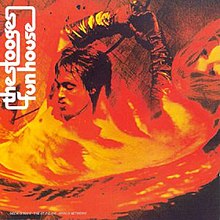Fun House (The Stooges album)
| Fun House | ||||
|---|---|---|---|---|
 |
||||
| Studio album by The Stooges | ||||
| Released | July 7, 1970 | |||
| Recorded | May 11–25, 1970 | |||
| Studio | Elektra Sound Recorders in Los Angeles | |||
| Genre | ||||
| Length | 36:35 | |||
| Label | Elektra | |||
| Producer | Don Gallucci | |||
| The Stooges chronology | ||||
|
||||
| Professional ratings | |
|---|---|
| Review scores | |
| Source | Rating |
| AllMusic | |
| Chicago Tribune | |
| Christgau's Record Guide | A– |
| Entertainment Weekly | A+ |
| Mojo | |
| MusicHound Rock | 5/5 |
| Pitchfork | 9.4/10 |
| Q | |
| The Rolling Stone Album Guide | |
| Spin Alternative Record Guide | 10/10 |
Fun House is the second studio album by American rock band The Stooges. It was released on July 7, 1970 by Elektra Records.
Though initially commercially unsuccessful, Fun House developed a strong cult following and, like its successor (1973's Raw Power), is generally considered integral in the development of punk rock.
Even though Elektra Records' Jac Holzman believed that MC5 had more potential than The Stooges, he made the crucial intervention to ask former Kingsmen keyboardist Don Gallucci to produce the album. Having seen the group live, Gallucci told Holzman that The Stooges were an "interesting group, but I don't think you can get this feeling on tape". Holzman said it didn't matter because he had already reserved recording time in L.A. The album was recorded at Elektra Sound Recorders in Los Angeles, California from May 11 to May 25, 1970. Gallucci's plan as a producer was to use each day to record about a dozen takes of a particular song and then pick the one that would appear on the album. The first day consisted of sound checking and run-throughs of all songs. The entire band used headphones with the bass and drums isolated by baffles while singer Iggy Pop sang his vocals through a condenser microphone on a boom.
The result was terrible in the band's opinion. They took exception to the atmosphere inside the studio with soundproof padding and isolators. To achieve their vision, The Stooges and Gallucci stripped the entire studio of its usual gear to emulate their live performances as closely as possible. According to Gallucci, they set up the band in the way they normally play at a concert. For example, Pop was singing through a handheld microphone, and the guitar and bass amps were placed side by side. The results were very raw when compared to many contemporary records; for example, without the normal isolation baffles the vibrations from the bass amplifier cause audible rattling of the snare drum on several songs.
Pop indicated that iconic blues singer Howlin' Wolf "was really pertinent for me on Fun House. That stuff is Wolfy, at least as I could do it."
...
Wikipedia
